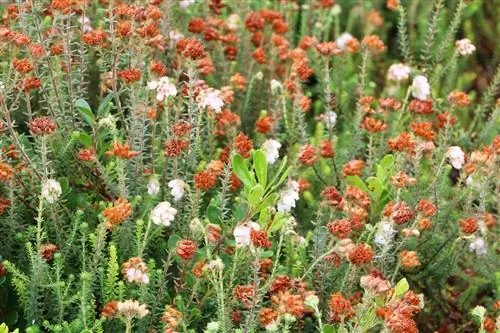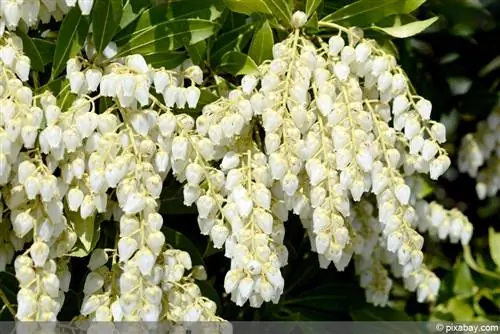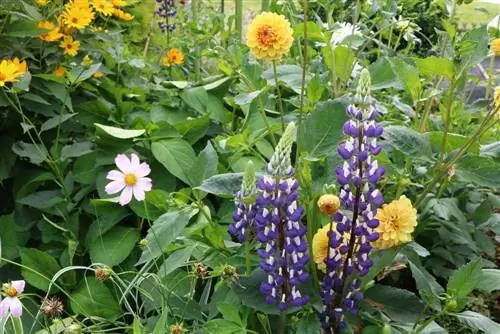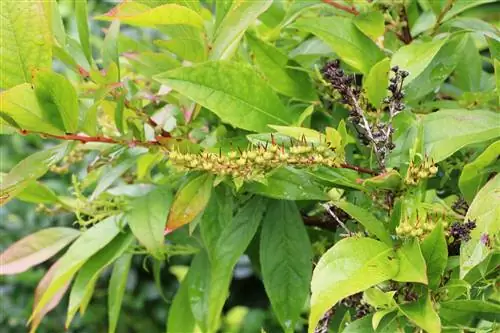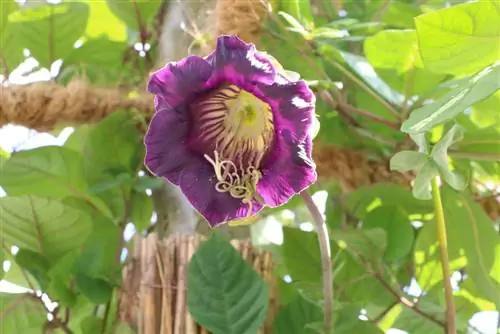- Author admin [email protected].
- Public 2023-12-17 03:39.
- Last modified 2025-01-24 12:45.
The bell heather impresses many hobby gardeners with its bright flowers, who like to plant the perennial plant in a bog bed or in balcony boxes.
The best known species of bell heather are Erica gracilis and Erica tetralix. Both come from different backgrounds, even if they have the same care requirements.
- Erica gracilis comes from the Cape region of South Africa, while the distribution area of Erica tetralix is in Europe.
- Erica tetralix blooms between June and September and Erica gracilis between August and October with white, pink or red flowers.
Plants
The best planting time for bell heather is from September to November or from March to May:
- Dip the bale in water first
- Loosen the soil well beforehand
- dig deep planting hole
- Root ball must be covered by 0.5 cm with substrate
- Press the root ball well and water it generously
If there is no rain after planting, you must water daily and abundantly so that the bell heather grows well.
Location
The bell heather loves a sunny to partially shaded location. However, it does not like direct sunlight, otherwise its leaves will dry out very quickly. Erica tetralix & gracilis are also suitable for planting outside the garden:
- Grave planting
- Balcony boxes
- Troughs
Floor
The bell heather feels most at home in a bog bed next to rhododendrons, azaleas, blueberries and cranberries. The substrate in the bog bed consists of lime-free, humus-rich, acidic and moist sandy or peat soil. For example, commercially available rhododendron soil is well suited for a peat bed. If you want to put together your own substrate, use one part peat or peat substitute, one part bog soil and three parts conifer soil and mix everything with a little sand. For heather herbs and all other ericaceous plants, it is very important that they grow in moist soil, but that no waterlogging can form.
Pouring
In order for Erica tetralix and Erica gracilis to bloom for months, they need regular and abundant watering. The plants dry out quite quickly if they don't get enough water. This often occurs when planting in pots or balcony boxes. When it comes to water quality, care must be taken to ensure that it is lime-free water, preferably rainwater.
Tip:
The root ball of the bell heather must always be slightly moist and must never dry out, regardless of whether it is in a bed or in a pot or bucket.
Fertilize
The nutrient requirements of bell heather are low, but fertilization, which is generally applied in moorland for rhododendrons or azaleas, for example, does not harm them. On the contrary, they are stimulated to grow. Bell heather kept in pots should be fertilized with liquid flowering plant fertilizer at regular intervals of 4 weeks.
Cutting
The dwarf shrubs should be cut back every year after flowering so that they get a nice bushy shape and don't become bare inside.
Tip:
In the first year, cut the plant back to 2/3 and in subsequent years only to just above the previous year's cutting height.
Propagate
Erica tetralix and Erica gracilis are usually propagated by cuttings, division or planting. Propagation using seeds is possible, but very difficult and has therefore not become established as a standard method.
Cuttings
To propagate Erica cuttings, you can use shoot or head cuttings that are already slightly woody. Be careful not to crush the stems when cutting them. The cuttings are inserted into bog soil or self-made bog plant substrate. Pots and bowls are best suited for this. Put a piece of foil over it to create a good growing climate and ventilate every now and then. If you like, you can stick the cuttings straight into the moor bed without first cultivating them in pots. However, the small cuttings can dry out quickly, while the large plants already have enough water stored in their roots if you forget to water the moor bed.
Division
You can separate the root ball of the heather with a sharp knife to get two or more parts. Always make sure that there are strong shoots and roots on all parts. The sections are simply planted in a new place in the bog bed or cultivated in pots.
Lowers
- place a strong side shoot on the ground
- Pile up shoots or weigh them down with stone
- water regularly
Wintering
It is hardly worth overwintering Erica gracilis in the bed in cold regions, as it freezes to death at temperatures below -6 °C. It is therefore better to take them out of the bog bed and overwinter them indoors. Hobby gardeners could have better luck with Erica tetralix, as it is considered hardy. But here too it is rarely successful because people often forget to water them in the garden in winter. The Erica must never dry out, even in winter! The heather herbs are overwintered indoors at temperatures between 5 and 10 °C. The winter location should be light. A sunny to semi-shady place in the house is therefore ideal. Keep the plant substrate moist even in winter. But don't water too much as the roots can rot!
Planting combinations
As a typical moor plant, the bell heather gets along very well with plants that have similar requirements for soil and sunlight, such as:
- Lavender heather
- fever clover
- Irish Heath
- Rhododendrons
- Outdoor azaleas
- narrow-leaved cotton grass
- Blueberry
- Cranberry
- Calmus
- Swamp Porst
- wood anemones
- Lungwort
- Bearberry
- Lark Spur
Diseases and pests
The bell heather can sometimes suffer from powdery mildew or gray mold, but pests such as heather leaf beetles or aphids can also attack it.
Mildew
You can counteract mildew with a milk-water mixture. To do this, prepare a mixture of 10% whole milk and 90% water. The liquid is sprayed onto the affected Erica plants using a sprayer.
Gray horse
With gray mold, it is advisable that you plant or pot up the affected plants. Cut off all affected plant parts and allow the plants to air dry briefly. Then take fresh plant substrate and fresh, germ-free pots or balcony pots if you keep the Erica in pots. If you have gray mold in the moor bed, it is advisable to completely cover the bed with new substrate. In the meantime, plant the infected plants in germ-free pots and germ-free substrate. Only put the plants back in the new bed when gray mold no longer appears. If the gray mold has progressed too far, then unfortunately the only solution is to dispose of the plants so that the mold disease does not spread any further.
Heather leaf beetles and aphids
In addition to common biological sprays with garlic, nettle, horsetail, tansy or neem tree seeds, songbirds also help to destroy the pests, provided they find sufficient nesting places in your garden.
Conclusion of the editors
Caring for bell heather, also known as moor heather, is actually not that difficult if you make sure that its root ball stays moist and never dries out. This is particularly important when kept in pots. However, waterlogging is just as damaging as drought. If the bell heather is planted in combination with other moor plants, it feels most comfortable.
What you should know about the Glockenheide in brief
Location
- The bell heather prefers a bright location, but without direct sunlight.
- If there is too much sun, the leaves dry out quickly and fall off.
- The temperatures should not be too high, between 7 and 11 °C.
- The humidity must be high if possible.
- If you place the plants in a protected place, they can survive frosts down to -5 °C.
Planting substrate
- The plant substrate should definitely be acidic and humic.
- A mixture of three parts coniferous soil, 1 part moorland, 1 part peat and some coarse sand is ideal.
- You can also simply use standard soil and peat in equal parts.
Watering and fertilizing
- The bell heather needs plenty of water, then it blooms for months.
- If it doesn't get enough water, it will dry out quite quickly. It's best to use rainwater.
- Hard water is not tolerated. It can cause the plants to die.
- The root ball should always be slightly moist. It must not dry out.
- Fertilized every 4 weeks with a liquid flowering plant fertilizer.
Wintering
- Usually overwintering the bell heather is hardly worth it.
- If you still want to try it, give the plants a bright winter quarters at temperatures around 5 °C.
- The root ball should be slightly moist and must not die under any circumstances. This kills the plant. Too much wetness too.
Cutting
- The bell heather is cut directly after flowering.
- In the first year it is cut back to 2/3, later only a little above the previous year's cutting height.
Propagate
- Propagation by seeds is difficult, but possible.
- You can also cut head or partial cuttings and propagate the plant from side shoots.
- Head cuttings are also possible. Do not take cuttings that are too woody and they must not be crushed.
Diseases and pests
- Glockenheide occasionally suffers from iron deficiency.
- Gray mold and mildew can occur, but are rare.
- Pests include black weevils, heather leaf beetles and aphids.

